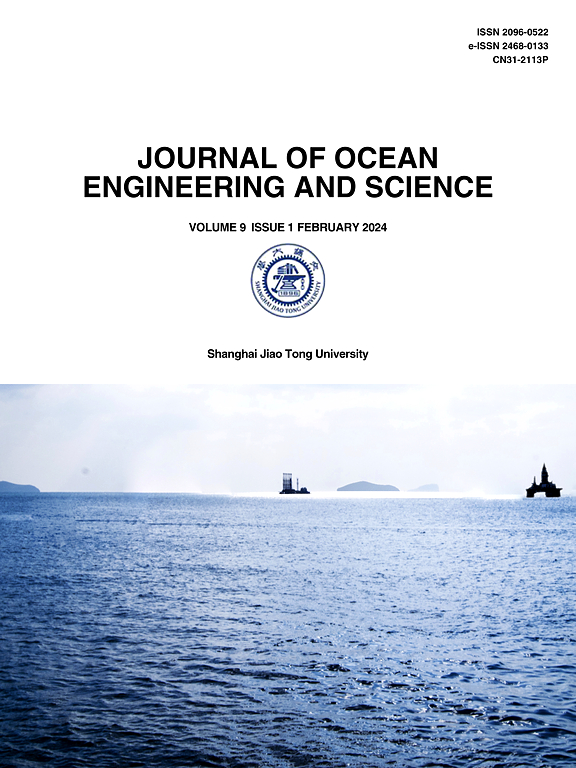Design and comparative analysis of mooring systems for a combined wind and wave energy system at intermediate water depth
IF 11.8
1区 工程技术
Q1 ENGINEERING, MARINE
引用次数: 0
Abstract
For intermediate water depths (typically ranging from 50 m to 80 m), designing steel catenary mooring systems for floating marine renewable energy (FMRE) platforms can be challenging due to the limited weight of suspended mooring lines. This can substantially increase mooring line tensions following large platform offsets. In contrast, mooring systems using synthetic fibre ropes offer the potential to prevent large platform offsets while reducing peak mooring line tensions. In this study, novel semi-taut mooring systems incorporating polyester ropes and steel chains are proposed for a combined wind and wave energy system – the semi-submersible flap torus combination (STFC) concept, deployed at a 50 m water depth. The STFC integrates a semi-submersible floating offshore wind turbine (FOWT), a torus wave energy converter (WEC) and three flap-type WECs. The dynamic responses of the STFC with different semi-taut mooring configurations under operational and survival environmental conditions are assessed in terms of key performance parameters such as the platform's motion responses and mooring line tensions. These performance parameters are compared against those of a chain-catenary mooring system. With the use of semi-taut mooring systems, significantly smaller mooring footprints as compared to the chain-catenary mooring systems can be achieved. Moreover, it is demonstrated that the semi-taut mooring systems are effective in reducing the maximum tension of the mooring lines. A basic cost analysis further indicates that semi-taut mooring systems offer substantial cost advantages over chain-catenary moorings in intermediate water depths.
中等水深风波能联合系统系泊系统设计与对比分析
对于中等水深(通常为50米至80米),由于悬挂系缆的重量有限,为浮动海洋可再生能源(FMRE)平台设计钢制悬链线系泊系统可能具有挑战性。这可以大大增加大型平台偏移后的系泊线张力。相比之下,使用合成纤维缆绳的系泊系统可以防止大平台偏移,同时降低系泊线的峰值张力。在这项研究中,提出了一种新型的半紧系泊系统,包括聚酯绳和钢链,用于风力和波浪能组合系统-半潜式襟翼环面组合(STFC)概念,部署在50米水深。STFC集成了一个半潜式浮动海上风力涡轮机(FOWT),一个环面波浪能转换器(WEC)和三个襟翼型WECs。根据平台运动响应和系泊线张力等关键性能参数,评估了不同半紧系泊配置的STFC在运行和生存环境条件下的动态响应。将这些性能参数与链悬链系泊系统的性能参数进行了比较。与链式悬链系泊系统相比,使用半紧系泊系统可以实现更小的系泊足迹。结果表明,半紧系泊系统能有效降低系泊索的最大张力。一项基本的成本分析进一步表明,在中等水深,半紧系泊系统比链式悬链链系泊系统具有显著的成本优势。
本文章由计算机程序翻译,如有差异,请以英文原文为准。
求助全文
约1分钟内获得全文
求助全文
来源期刊

Journal of Ocean Engineering and Science
Multiple-
CiteScore
11.50
自引率
19.70%
发文量
224
审稿时长
29 days
期刊介绍:
The Journal of Ocean Engineering and Science (JOES) serves as a platform for disseminating original research and advancements in the realm of ocean engineering and science.
JOES encourages the submission of papers covering various aspects of ocean engineering and science.
 求助内容:
求助内容: 应助结果提醒方式:
应助结果提醒方式:


